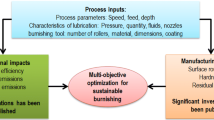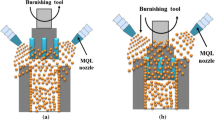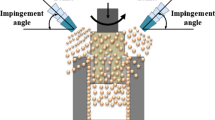Abstract
In the current work, the optimal factors are selected to achieve the improvements in the energy consumption (EB), power factor (PB), decreased roughness (DR) and improved surface hardness (IH) for the roller burnishing operation. The process inputs are the burnishing speed (V), the feed (f), and the depth (d). A hybrid approach comprising the principal component analysis and Technique for Order of Preference by Similarity to Ideal Solution was used to explore the weight values of burnishing performances and select the optimum parameters. Moreover, another optimization technique employing the response surface method and archive-based micro-genetic algorithm was adopted to identify the optimal outcomes in the continuous domain. The main findings showed the performances measured are primarily affected by the burnishing feed, depth and speed, respectively. The energy consumption and roughness are approximately decreased by 31.46% and 7.41%, while the power factor and hardness are improved by 17.47% and 43.09%, respectively, as compared to the general process. The outcomes and findings of the investigated work can be used for further research in sustainable design and manufacturing as well as directly used in the knowledge-based and expert systems for burnishing applications in industrial practices.











Similar content being viewed by others
References
El-Taweel, T. A., & El-Axir, M. H. (2009). Analysis and optimization of the ball burnishing process through the Taguchi technique. The International Journal of Advanced Manufacturing Technology,41, 301–310.
John, R. S., & Vinayagam, B. K. (2011). Optimization of ball burnishing process on tool steel (T215Cr12) in CNC machining centre using response surface methodology. Arabian Journal for Science and Engineering,36, 1407–1422.
Babu, P. R., Ankamma, K., Prasad, T. S., Raju, A. V. S., & Eswara Prasad, N. (2012). Optimization of burnishing parameters and determination of select surface characteristics in engineering materials. Sadhana,37, 503–520.
Tadic, B., Todorovic, P. M., Luzanin, O., Miljanic, D., Jeremic, B. M., & Bogdanovic, B., et al. (2013). Using specially designed high-stiffness burnishing tool to achieve high-quality surface finish. The International Journal of Advanced Manufacturing Technology,67, 601–611.
John, M. R. S., & Vinayagam, B. K. (2014). Optimization of nonlinear characteristics of ball burnishing process using Sugeno fuzzy neural system. The Journal of the Brazilian Society of Mechanical Sciences and Engineering,36, 101–109.
Revankar, G. D., Shetty, R., Rao, S. S., & Gaitonde, V. N. (2014). Analysis of surface roughness and hardness in ball burnishing of titanium alloy. Measurement,58, 256–268.
Cobanoglu, T., & Ozturk, S. (2015). Effect of burnishing parameters on the surface quality and hardness. Proceedings of the Institution of Mechanical Engineers Part B Journal of Engineering,229(2), 286–294.
Banh, Q. N., & Shiou, F. J. (2016). Determination of optimal small ball-burnishing parameters for both surface roughness and superficial hardness improvement of STAVAX. Arabian Journal for Science and Engineering,41(2), 639–652.
Yuan, X. L., Sun, Y. W., Gao, L. S., & Jiang, S. L. (2016). Effect of roller burnishing process parameters on the surface roughness and microhardness for TA2 alloy. The International Journal of Advanced Manufacturing Technology,85, 1373–1383.
Amdouni, H., Bouzaiene, H., Montagne, A., Nasri, M., & Iost, A. (2017). Modeling and optimization of a ball-burnished aluminum alloy flat surface with a crossed strategy based on response surface methodology. The International Journal of Advanced Manufacturing Technology,88, 801–814.
Teimouri, R., Amini, S., & Bami, A. B. (2018). Evaluation of optimized surface properties and residual stress in ultrasonic assisted ball burnishing of AA6061-T6. Measurement,116, 129–139.
Nguyen, T. T., & Le, X. B. (2018). Optimization of interior roller burnishing process for improving surface quality. Materials and Manufacturing Processes,33(11), 1233–1241.
Nguyen, T. T., & Le, X. B. (2019). Optimization of roller burnishing process using Kriging model to improve surface properties. Proceedings of the Institution of Mechanical Engineers, Part B,233(12), 2264–2282.
Chinnaiyan, P., & Jeevanantham, A. K. (2014). Multi-objective optimization of single point incremental sheet forming of AA5052 using Taguchi based grey relational analysis coupled with principal component analysis. International Journal of Precision Engineering and Manufacturing,15, 2309–2316.
Soepangkat, B. O. P., Pramujati, B., & Effendi, M. K., et al. (2019). Multi-objective optimization in drilling kevlar fiber reinforced polymer using grey fuzzy analysis and backpropagation neural network-genetic algorithm (BPNN–GA) approaches. International Journal of Precision Engineering and Manufacturing,20, 593–607.
Zhang, F. Y., Chen, J. L., & Li, T. T., et al. (2019). Study and optimization of structural parameters of oil seal by response surface method. International Journal of Precision Engineering and Manufacturing,20, 255–265.
Acknowledgements
This research is funded by Vietnam National Foundation for Science and Technology Development (NAFOSTED) under Grant Number 107.04-2020.02.
Author information
Authors and Affiliations
Corresponding author
Ethics declarations
Conflict of interest
The author(s) declared no potential conflicts of interest with respect to the research, authorship, and/or publication of this article.
Additional information
Publisher's Note
Springer Nature remains neutral with regard to jurisdictional claims in published maps and institutional affiliations.
Rights and permissions
About this article
Cite this article
Nguyen, TT., Cao, LH. Optimization of the Burnishing Process for Energy Responses and Surface Properties. Int. J. Precis. Eng. Manuf. 21, 1143–1152 (2020). https://doi.org/10.1007/s12541-020-00326-8
Received:
Revised:
Accepted:
Published:
Issue Date:
DOI: https://doi.org/10.1007/s12541-020-00326-8




